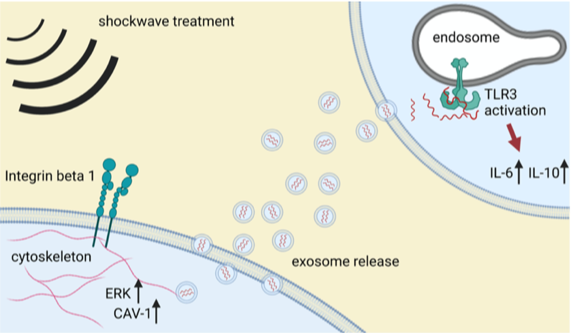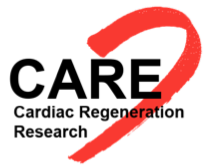We explore shock wave therapy as regenerative tool for the treatment of ischemic heart failure. We could show in numerous publications the potent angiogenic effect resulting in decreased myocardial scarring and improved left ventricular function in cell culture and small animal models1-3. We uncovered the molecular mechanisms how the mechanical stimulus is translated into a biological response. SWT creates a physical stimulus that induces the release of specific extracellular vesicles containing angiogenic cargoes4. Angiogenic growth factors, partly bound to the extracellular matrix, are released and cause endothelial cell proliferation and tube formation, resulting in efficient angiogenesis and arteriogenesis in the border zone of ischaemic hearts1. The factors released upon SWT stimulate the innate immune receptor Toll-like receptor 3 (TLR3), leading to a modulation of the inflammatory response further inducing the regeneration of the ischaemic myocardium (Figure). In TLR3 knock-out mice the effect of SWT is abolished5. We developed the world’s smallest shock wave applicator to initiate translation and confirmed the regeneration of ischemic myocardium with improvement of left ventricular function in a large animal model6.

Based on the results from our preclinical trials, our urgent goal was to translate our findings efficiently into a clinical study. We therefore initiated the CAST-HF trial (www.cast-trial.com), the first investigator-initiated prospective, randomized, sham-controlled trial aiming to assess the safety and efficacy of direct cardiac shockwave therapy in addition to CABG surgery in patients with ischemic heart failure.
Key papers:
Gollmann-Tepeköylü C, Lobenwein D, Theurl M, et al. Shock Wave Therapy Improves Cardiac Function in a Model of Chronic Ischemic Heart Failure: Evidence for a Mechanism Involving VEGF Signaling and the Extracellular Matrix. Journal of the American Heart Association 2018;7(20). DOI: 10.1161/jaha.118.010025.
Tepeköylü C, Wang F-S, Kozaryn R, et al. Shock wave treatment induces angiogenesis and mobilizes endogenous CD31/CD34-positive endothelial cells in a hindlimb ischemia model: implications for angiogenesis and vasculogenesis. The Journal of thoracic and cardiovascular surgery 2013;146(4):971-8. DOI: 10.1016/j.jtcvs.2013.01.017
Gollmann-Tepekoylu C, Polzl L, Graber M, et al. miR-19a-3p containing exosomes improve function of ischemic myocardium upon shock wave therapy. Cardiovasc Res 2019 (In eng).DOI: 10.1093/cvr/cvz209.
Holfeld J, Tepekoylu C, Reissig C, et al. Toll-like receptor 3 signalling mediates angiogenic response upon shock wave treatment of ischaemic muscle. Cardiovasc Res 2016;109(2):33143. DOI: 10.1093/cvr/cvv272.
Holfeld J, Zimpfer D, Albrecht-Schgoer K, et al. Epicardial shock-wave therapy improves ventricular function in a porcine model of ischaemic heart disease. J Tissue Eng Regen Med 2016;10(12):1057-1064. DOI: 10.1002/term.1890.
